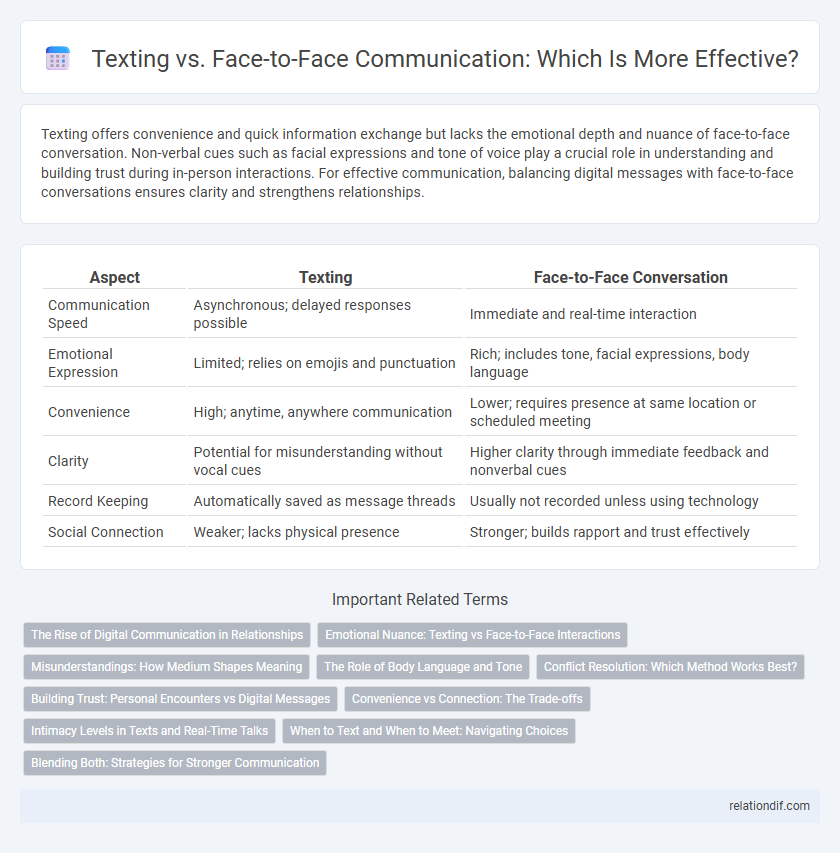Texting offers convenience and quick information exchange but lacks the emotional depth and nuance of face-to-face conversation. Non-verbal cues such as facial expressions and tone of voice play a crucial role in understanding and building trust during in-person interactions. For effective communication, balancing digital messages with face-to-face conversations ensures clarity and strengthens relationships.
Table of Comparison
| Aspect | Texting | Face-to-Face Conversation |
|---|---|---|
| Communication Speed | Asynchronous; delayed responses possible | Immediate and real-time interaction |
| Emotional Expression | Limited; relies on emojis and punctuation | Rich; includes tone, facial expressions, body language |
| Convenience | High; anytime, anywhere communication | Lower; requires presence at same location or scheduled meeting |
| Clarity | Potential for misunderstanding without vocal cues | Higher clarity through immediate feedback and nonverbal cues |
| Record Keeping | Automatically saved as message threads | Usually not recorded unless using technology |
| Social Connection | Weaker; lacks physical presence | Stronger; builds rapport and trust effectively |
The Rise of Digital Communication in Relationships
The rise of digital communication has significantly transformed relationships by making texting a dominant mode of interaction due to its convenience and immediacy. While face-to-face conversations provide richer emotional cues and nonverbal feedback essential for intimacy, texting offers asynchronous flexibility that supports ongoing connectivity. Studies indicate that balancing digital messages with in-person dialogue enhances relationship satisfaction and emotional understanding.
Emotional Nuance: Texting vs Face-to-Face Interactions
Texting often lacks the emotional nuance found in face-to-face conversations, as it misses vocal tone, facial expressions, and body language cues essential for conveying feelings accurately. Face-to-face interactions enable immediate feedback and a deeper emotional connection, reducing misunderstandings common in digital communication. Research shows that nonverbal signals account for up to 93% of emotional communication, highlighting the limitations of texting for expressing complex emotions.
Misunderstandings: How Medium Shapes Meaning
Texting often lacks vocal tone, facial expressions, and immediate feedback, increasing the potential for misunderstandings due to ambiguous or incomplete messages. Face-to-face conversations provide contextual cues and nonverbal signals that clarify intent, reducing misinterpretations and enhancing mutual understanding. The medium significantly impacts how meaning is conveyed and interpreted in communication exchanges.
The Role of Body Language and Tone
Body language and tone play critical roles in face-to-face conversations, conveying emotions and intentions beyond spoken words through facial expressions, gestures, and vocal inflections. Texting lacks these nonverbal cues, often leading to misunderstandings or misinterpretations of the message's emotional context. Incorporating emojis and punctuation helps partially bridge this gap but cannot fully replicate the richness of in-person communication signals.
Conflict Resolution: Which Method Works Best?
Face-to-face conversation offers more effective conflict resolution by enabling nonverbal cues like tone, facial expressions, and body language, which reduce misunderstandings and foster empathy. Texting lacks these immediate contextual signals, often leading to misinterpretations and delayed responses that can escalate conflicts. Studies show in-person dialogue increases the likelihood of collaborative problem-solving and emotional connection, making it the superior method for resolving disputes.
Building Trust: Personal Encounters vs Digital Messages
Face-to-face conversations build trust more effectively than texting by enabling immediate feedback, tone interpretation, and nonverbal cues. Physical presence fosters emotional connection and sincerity, essential for deepening trust in relationships. Digital messages often lack these elements, leading to potential misunderstandings and weaker trust development.
Convenience vs Connection: The Trade-offs
Texting offers unparalleled convenience by enabling instant communication anytime and anywhere, allowing users to multitask and maintain relationships across distances. However, face-to-face conversation fosters deeper emotional connection and richer interaction through nonverbal cues, tone, and immediate feedback. Balancing the efficiency of texting with the meaningful engagement of in-person dialogue is essential for effective communication.
Intimacy Levels in Texts and Real-Time Talks
Texting often lacks the depth of vocal tone, facial expressions, and immediate emotional feedback present in face-to-face conversations, resulting in lower intimacy levels. Real-time talks enable nuanced communication through nonverbal cues, fostering stronger emotional connections and empathy between participants. While texting offers convenience and asynchronous interaction, its limited expressiveness can hinder the development of deep, intimate bonds compared to in-person dialogue.
When to Text and When to Meet: Navigating Choices
Texting is ideal for quick updates, casual check-ins, or scheduling where immediate feedback is not critical, making it efficient for coordinating daily tasks and confirming plans. Face-to-face conversation becomes essential when discussing complex issues, resolving conflicts, or expressing emotions, as it allows for richer communication through tone, body language, and immediate interaction. Choosing between texting and meeting depends on the message's urgency, complexity, and the need for personal connection to ensure effective communication outcomes.
Blending Both: Strategies for Stronger Communication
Combining texting and face-to-face conversation enhances communication effectiveness by leveraging the immediacy of digital messages with the depth of in-person interactions. Strategies such as initiating important discussions in person while using texting for quick updates ensure clarity and emotional connection. Blending these methods improves relationship management and reduces misunderstandings in both personal and professional settings.
Texting vs face-to-face conversation Infographic

 relationdif.com
relationdif.com